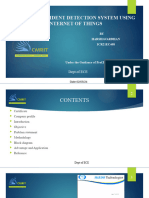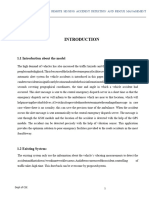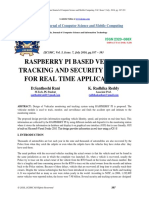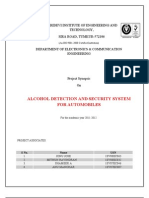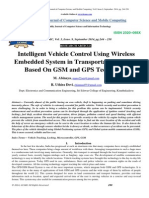IJCRT2305006
IJCRT2305006
Uploaded by
Gayathri ACopyright:
Available Formats
IJCRT2305006
IJCRT2305006
Uploaded by
Gayathri ACopyright
Available Formats
Share this document
Did you find this document useful?
Is this content inappropriate?
Copyright:
Available Formats
IJCRT2305006
IJCRT2305006
Uploaded by
Gayathri ACopyright:
Available Formats
www.ijcrt.
org © 2023 IJCRT | Volume 11, Issue 5 May 2023 | ISSN: 2320-2882
VEHICLE ACCIDENT DETECTION AND
ALERT
1
Prof. Rameshwari M . Medhane, 2Pawar Rohini Mohan, 3Chaudhari Pankaj Ratan, 4Gaikwad Gaytri
Digambar, 5Bhamare Lalit Nilesh,
1
Professor, 2Student, 3Student, 4Student, 5Student,
1
Electrical Department,
1
Sanghavi College of Engineering, Maharashtra, India
Abstract: Proposed system will detect accident and provide alert on webpage with the live location of vehicle. Accidental
situation will be identified with reference to the high acceleration, high & sudden tilt in vehicle, bumps. When the case occurs, an
emergency alert message will be uploaded to the webpage to notify the authorities and family members of vehicle owner with the
location co-ordinates. Location of vehicle will be tracked using GPS module. In this system, an accelerometer module and bump
detection module are used to detect accidents. Both sensors sends signal to arduino board. Arduino board scan the GPS location
from GPS module. Both the accident status and location of vehicle are uploaded on IOT application through WiFi module. Similarly
SMS will be send to emergency contact through web cloud. Complete process will be displayed on LCD display. A buzzer will be
turned on in case of accident for attention locally.
Index Terms – Vehicle accident, IOT, SMS, Arduino.
I. INTRODUCTION
There is an alarming increase in the morbidity and mortality due to two wheeler road traffic accidents. This has been a
matter of great concern globally. In India, it is estimated that one accident takes place every 2 minutes. Data from the National
Crime Records Bureau indicates that deaths and injuries related to road traffic accident has increased two and four fold respectively
during the period of 1991–2005. Reportedly 98,254 persons were killed in 2005 on Indian roads [1]. The occupants and riders of
two wheeler vehicles are among the majority to be affected in road traffic accidents. Two wheeler accidents have also been shown
to have maximum case fatality in accidents. Despite of the safety rules made by the government, many riders fail to abide by them.
As transportation is booming all over the world, where the count of vehicles increasing day by day. Security and safety of
those vehicles is a risky one. Monitoring vehicle and alert in case of accident & digital locking system is a much needed one in this
digital world. Tracking of our vehicle is also a vital one when your vehicle is not with you. In case of accident, it is important that
alert must be send to family members with location of accident. Proposed system will allow access to only authorized person so
that no one can stole your vehicle. This access is given through fingerprint matching. Other than this system will monitor the
parameters regarding accidental situation using microcontroller & sensors. Accidental situation will be identified with reference to
the high acceleration, high & sudden tilt in vehicle, bumps. When the case occurs, an emergency alert message will be uploaded to
the webpage to notify the authorities and family members of vehicle owner with the location co-ordinates. Location of vehicle will
be tracked using GPS module on IOT webpage.
II. NEED OF PROJECT
All over the world, negligence while driving cause to lose life in many cases of accident. Drunk and drive, use of mobile
causes to lose many life as per road and transportation ministry. Collisions in automobiles have become a major safety concern;
cases of damage and death due to automobile collisions are frequently reported. In most of the cases, delay in medical help causes
to death of person. So its extremely important that accident person get medical help immediately. An emergency help can save the
life.
III. OBJECTIVES
One main goal of this project is the development of a low-cost autonomous sensor system which will provide immediate
alert in case of accident. Some of design objectives of system are as bellow:
• Detect accident using ADXL accelerometer sensor module.
• To track location using GPS Neo6m & upload coordinates to the webpage.
• Design thingspeak server for IOT webpage.
• Immediate alert generation on webpage in case of accident.
IJCRT2305006 International Journal of Creative Research Thoughts (IJCRT) www.ijcrt.org a34
www.ijcrt.org © 2023 IJCRT | Volume 11, Issue 5 May 2023 | ISSN: 2320-2882
IV. LITERATURE SURVEY
A review of existing security systems implemented in automobiles was done and below are some of the findings found. Based on
this review some solutions were proposed to improve certain functional security aspects of the antitheft system that we are going try
to implement in this project. A number of developments have taken place in anti-theft systems for vehicles and some of the relevant
ones are as follows:
1. In this work[1], an advanced vehicle monitoring and tracking system is proposed and designed for the purpose of monitoring the
vehicles which are moving from one place to the other in order to provide safety and security. The proposed method puts together
superior exercise of contemporary technology by means of Embedded C programming language and the unit developed via LPC2148
and its sophisticated features of storing database. The work includes Global Positioning System (GPS) and Global System for Mobile
Communication (GSM) for vehicle tracking and monitoring purpose using SIM800 module. The GPS provides present site of the
vehicle; GPRS sends the tracking information to the server and thus an alert message generated is transmitted to the owner of the
vehicle. This scheme is deployed in the interior of the vehicle whose location is to be determined on the web page and supervised at
real time. Hence, if the driver drives the vehicle on the wrong path then the alert message will be sent from the proposed system to
the vehicle’s owner mobile and if the vehicle’s driver feels drowsy or drunk then also the warning sound is produced by Buzzer. The
proposed system take care of the traveler’s safety by using Alcohol sensor to find the status of the driver and Temperature sensor to
monitor vehicle Engine Temperature to avoid sparking of the vehicle their by preventing from the disaster.
Research Gap: In this paper, though multiple parameters are monitored, it has lack of lack of precautionary measures against
robbery and vehicle control. The use of high power processor carries redundant processing power and makes system costly.
2. Voice based starting engine access control system potentially replaces these main functions by replacing the key with the specific
user voice. In the proposed system[2], the access may be authorized simply by means of an enrolled user speaking into a microphone
attached to the system. The proposed system then will decide whether the word is ‘On’ or ‘Off’. The decision voice will be sent to
Arduino in order to activate the automotive relay, which will be used to activate the engine’s motor starter. Furthermore, the intelligent
system approach is used to develop authorized words model based on the voice. Particularly Support Vector Machines based
classification system is used in the proposed system to identify the authorized words. Experimental results confirm the training and
testing accuracy of 100% and 92.15%, respectively.
Research Gap: Here voice activation is use for vehicle control. Unfortunately in open environment voice detection is far more
difficult due to presence of surrounding noise. Again the need of high end processor and large memory requirement increases the
system cost.
3. The utilization of ARM 7 microcontroller, GSM and GPS module together with an accelerometer and temperature sensor is carried
out by Joshi and Mahajan [6]. The GPS and GSM module is being utilized for following the area of vehicle. The extra part is being
included is the accelerometer which essentially contains the MEMS sensor offering a low pass filter and is fundamentally utilized for
Shake Detection, Orientation Detection and Tap Detection. The utilization of temperature sensor is additionally being carried out
with a specific end goal to acquire the vehicle engine temperature which changes over the estimation of temperature into electrical
signal.
Research Gap: In above system, GSM is used, which has lack of continuous tracking & showing data logs since it works over
SMS & call services. Since system requires less processing power, use of ARM7 processor increases the cost due to redundant
processing power.
4. A hybrid GPS-GSM localization of vehicles Tracking System has been developed by Al-Khedher [7] that portrays an incorporated
GPS-GSM framework to track vehicles utilizing Google Earth application. The remote module has a GPS mounted on the moving
vehicle to recognize its present position, and to be exchanged by GSM with different parameters procured by the car's information
port as a SMS to a beneficiary station. The received GPS directions or coordinates are sifted utilizing a Kalman filter to upgrade the
precision of measured position. After information processing, Google Earth application is utilized to view the current area and status
of every vehicle. This objective of this framework is to oversee armada, police cars dissemination and auto burglary alerts.
Research Gap: In above system, only vehicle tracking is implemented. Here GSM technology is used, which has lack of
continuous tracking & showing data logs since it works over SMS & call services.
5. Shaikh [8] describes arm7 based smart car security system. The principle point of this undertaking is to offer a development security
framework in automobile, which comprises of a face detection subsystem, a GPS module, a GSM module and a control stage. The
face location subsystem can discover confronts in vehicle amid the period in which no one ought to be in the auto, and make an alert
uproariously or soundlessly. Alternate modules transmit vital data to clients and help to keep eyes on vehicle constantly, actually
when the vehicle is lost. This framework model is based on the base of one inserted stage Arm7 which controls all the processes.
Research Gap: Here due to the use of high processing power system becomes costly. Again face detection procedure is time based
here which is not active 24x7. The use of GSM technology doesn’t provide sufficient information with compare to processing power
used.
6. J.M. Hu [9] describes vehicles against robbery framework utilizing GSM and GPS module. The framework is created utilizing fast
blended sort single-chip C8051f120 and stolen vehicle is discovered by the utilization of vibration sensor. The framework stays in
contact with auto holder through the GSM module, for the safety and reliability of car.
Research Gap: In this paper, resources are against robbery only and the communication method used is GSM. This doesn’t uses
resources sufficiently. Lack of precautionary measures against robbery and vehicle control is noted here.
IJCRT2305006 International Journal of Creative Research Thoughts (IJCRT) www.ijcrt.org a35
www.ijcrt.org © 2023 IJCRT | Volume 11, Issue 5 May 2023 | ISSN: 2320-2882
Overview:
In some of the researches processors with high processing power are used which unnecessarily increases the system cost with
redundant processing power. Where as in some papers its noted that the system is dedicated for specific type of vehicles and performs
only limited operations like only vehicle control or only accident detection. So after studying different research papers, it is noted
that a system which opposes the robbery of vehicle in cost effective way is needed to design which utilizes the resources in effective
way and monitors multiple parameters. A perfect solution for providing alert and for visualization of data is to be added to make the
accessibility easy.
V. BLOCK DIAGRAM
Figure 1: System Block Diagram
VI. CIRCUIT DIAGRAM
Figure 2: Connection Diagram
IJCRT2305006 International Journal of Creative Research Thoughts (IJCRT) www.ijcrt.org a36
www.ijcrt.org © 2023 IJCRT | Volume 11, Issue 5 May 2023 | ISSN: 2320-2882
VII. SYSTEM POWER REQUIREMENT:
Table 1: System Power Requirement:
Component Max Voltage needed Max Current needed Power
(V) (mA) needed
Arduino Nano 6 100 0.6
GPS Module 5 200 1.0
Accelerometer module 5 20 0.1
Buzer 5 50 0.25
LCD 5 50 0.25
WiFi Module 3.3 200 6.6
Total Power 8.8 Watts
From above table, we can say,
Here, 6V, 2Amp power source can be used.
Total supply power= 6x2=12Watts
5V & 3.3V output can be taken from arduino board
VIII. RESULT:
Once vehicle is turned on, it will connect to internet using wifi module. It’s continuously updating its location as shown in
figure 3 and also coordinates on blynk App. On detection of accident, buzer will be on to get local help & accident alert will be shown
on Android application. Similarly SMS with accident alert and location coordinate will be send to the emergency contacts as shown
in figure 6.2.2. Live location can be seen on google map by clicking on the link in the SMS as shown in figure below
Figure 3: Hardware results after turning on the vehicle
IJCRT2305006 International Journal of Creative Research Thoughts (IJCRT) www.ijcrt.org a37
www.ijcrt.org © 2023 IJCRT | Volume 11, Issue 5 May 2023 | ISSN: 2320-2882
Figure 4: SMS Alert for Accident Detection
IX. PERFORMANCE EVALUATION
Table 2: Performance Evaluation of project
Sr. No. Parameter Results
1 Time required to update data on webserver 15 Sec.
2 Time required to receive SMS after accident detection 40 Sec.
3 Number of users can access the Application at a time >20
4 Number of emergency contacts for SMS >3
5 GPS accuracy +/- 15meters
6 Accident detection accuracy 80%
As per the results of system, time required to upload data on varies with internet connection speed and network. But on an
average, its 15 seconds. After uploading data to the server, it can be seen immediately on Blynk application. GPS module neo6m
provides very fast location update. But its location accuracy observed is within 15 meter radius. GPS provides most accurate readings
with accuracy of less than 5meters when tested in open environment. But its loses accuracy when vehicle is not in open environment.
This situation can be avoided by using the better antenna for module. Multiple number of users can access the application at a time.
Similarly more than 1 contacts can be added for SMS alert in case of accident. Here system takes time of 4 seconds to send SMS to
each contact. The result of accident detection depends on the values generated by ADXL345 accelerometer sensor, due to the fast
response of sensor sometimes it shows accident while driving on irregular surfaces. Out of 50 accident alerts, 10 cases are the false
alert. So considering this scenario, accuracy for accident detection is 80%. This accuracy can be increase in future by improving the
detection code of microcontroller.
X. CONCLUSION
As considering safety and security of vehicle and driver, this system will play very important role. With the reliable way to
provide alert using android application & SMS alert, the medical help can be provided. Features like accident detection and GPS
location tracking makes system more powerful. Tracking of vehicle trough IOT application makes possible to check current status
and past details of vehicle any time and also reachable to infinite number of people at a time. With all these features, all the
transportation systems will be more secure.
XI. REFERENCES
[1] A.Anusha, Syed, Musthak Ahmed, “Vehicle Tracking And Monitoring System To Enhance The Safety And Security
Driving Using Iot”, IEEE International Conference on Recent Trends in Electrical, Electronics and Computing
Technologies-2017
[2] Winda Astuti, E. Byan Wahyu Riyandwita “Intelligent Automatic Starting Engine Based On Voice Recognition System”
IEEE Student Conference on Research and Development (SCOReD), 2016.
IJCRT2305006 International Journal of Creative Research Thoughts (IJCRT) www.ijcrt.org a38
www.ijcrt.org © 2023 IJCRT | Volume 11, Issue 5 May 2023 | ISSN: 2320-2882
[3] Ricardo Salazar Cabrera, Álvaro Pachón de la Cruz, “Public Transport Vehicle Tracking Service for Intermediate Cities
of Developing Countries, based on ITS Architecture using Internet of Things (IoT)”, 21st International Conference on
Intelligent Transportation Systems (ITSC) Maui, Hawaii, USA, November 4-7, 2018
[4] Bojan, T., Kumar, U., & Bojan, V. (2014). An internet of things based intelligent transportation system. 2014 IEEE
International Conference on Vehicular Electronics and Safety, 2014.
[5] M. A. Al-Taee, O. B. Khader, and N. A. Al-Saber, “ Remote monitoring of vehicle diagnostics and location using a smart
box with Global Positioning System and General Packet Radio Service,” in Proc. IEEE/ACS AICCSA, Amman, pp. 385–
388, 2007.
[6] M. S. Joshi and D. V. Mahajan, “Arm 7 based theft control, accident detection and vehicle positioning system,”
International Journal of Innovative Technology and Exploring Engineering, vol. 4, no. 2, pp. 29-31, July 2014.
[7] M.A.A. Khedher, “Hybrid GPS-GSM localization of automobile tracking system,” International Journal of Computer
Science and Information Technology, vol. 3, no. 6, pp. 75-85, Dec 2011.
[8] J. R. Shaikh and S. M. Kate, “Arm7 based smart car security system, International Journal of Engineering Trends and
Technology, vol. 3, no. 2, pp. 210-212, March 2012.
[9] J. M. Hu, J. Li, and G. H. Li, “Automobile anti-theft system based on GSM and GPS module,” presented at the Fifth
International Conference on Intelligent Networks and Intelligent Systems, Tianjin, China, November 1-3, 2012.
[10] Lee, S., Tewolde, G., & Kwon, J. (2014). “Design and implementation of vehicle tracking system using GPS/GSM/GPRS
technology and smartphone application”. IEEE World Forum on Internet of Things (WF-IoT). 2014.
[11] Mini, R., “A Cost Efficient Real-Time Vehicle Tracking System”. International Journal of Computer Applications (0975
– 8887), Volume 81 – No.11, November 2013
[12] Krishna, B.Vamsi, “Design and Development of Automated Public Transportation System and Traffic Guidance System”,
IOSR Journal of Electronics and Communication Engineering (IOSR-JECE), Jan.-Feb. 2017
Websites:
[13] http://www.ijrucc.org
[14] https://ieeexplore.ieee.org/
[15] http://www.learningaboutelectronics.com
[16] https://www.arduino.cc
[17] https://github.com
IJCRT2305006 International Journal of Creative Research Thoughts (IJCRT) www.ijcrt.org a39
You might also like
- Drive Test Route-Planning & VerificationDocument5 pagesDrive Test Route-Planning & VerificationUmar Abbas BabarNo ratings yet
- AP50 Autopilot ManualDocument46 pagesAP50 Autopilot ManualJimy Hendrix100% (1)
- An Automated Approach To Driving Assistance and Accident DetectionDocument3 pagesAn Automated Approach To Driving Assistance and Accident DetectionInternational Journal of Innovative Science and Research TechnologyNo ratings yet
- Ijst 2022 1018Document7 pagesIjst 2022 1018Edmealem GashawNo ratings yet
- IJCRT2207676Document6 pagesIJCRT2207676naaz808182No ratings yet
- Iot Based Implementation of Vehicle Monitoring and Tracking System Using Node McuDocument5 pagesIot Based Implementation of Vehicle Monitoring and Tracking System Using Node McujohnNo ratings yet
- 1 s2.0 S2665917423000570 MainDocument8 pages1 s2.0 S2665917423000570 MainnazalnavazNo ratings yet
- Manasa E3sconf - Icmpc2023 - 01159Document11 pagesManasa E3sconf - Icmpc2023 - 01159keerthana samalaNo ratings yet
- Gourav Sharma - GSM Based Fuel Theft Detection, Overspeed Indicator Nad Temprature Alert System in Petroleum Transportation VehicleDocument19 pagesGourav Sharma - GSM Based Fuel Theft Detection, Overspeed Indicator Nad Temprature Alert System in Petroleum Transportation VehicleRaj MandloiNo ratings yet
- ReportDocument92 pagesReportvimal10505No ratings yet
- Vehicle Tracking and Fuel Monitoring SystemDocument6 pagesVehicle Tracking and Fuel Monitoring SystemIJRASETPublicationsNo ratings yet
- Accident Reporting and Notification System For Incidents Involving Motor VehiclesDocument25 pagesAccident Reporting and Notification System For Incidents Involving Motor VehiclesCentral Asian StudiesNo ratings yet
- Application of Micro Controller in Vehicle Monitoring and Security SystemDocument6 pagesApplication of Micro Controller in Vehicle Monitoring and Security SystemEditor IJTSRDNo ratings yet
- Research Paper ECMDocument16 pagesResearch Paper ECMVarnit KashyapNo ratings yet
- Automatic Accident Detection and Emergency Alert System Using IoTDocument6 pagesAutomatic Accident Detection and Emergency Alert System Using IoTEditor IJTSRDNo ratings yet
- Data Logging SystemDocument5 pagesData Logging Systemandrew ratemoNo ratings yet
- AbstractDocument22 pagesAbstractSangeeta JamadarNo ratings yet
- Identification and Prevention of Accidents using Smart Helmet and GPS system_April 24Document7 pagesIdentification and Prevention of Accidents using Smart Helmet and GPS system_April 24Allanki Sanyasi RaoNo ratings yet
- Vehicle Monitoring, Tracking and Accident Rescue System Using IOTDocument4 pagesVehicle Monitoring, Tracking and Accident Rescue System Using IOTSamuel LumbanrajaNo ratings yet
- Zone Based Vehicle Speed Control SystemDocument13 pagesZone Based Vehicle Speed Control SystemSubash SubashanNo ratings yet
- Intelligent Vehicle Black Box System Using Iot: Iconnect-2023Document6 pagesIntelligent Vehicle Black Box System Using Iot: Iconnect-2023shaikshaikkarimulla43No ratings yet
- Plagiarism - Report For New OneDocument6 pagesPlagiarism - Report For New OnesivagamiNo ratings yet
- Mobile Collision and Secured System Using PIC ControllerDocument5 pagesMobile Collision and Secured System Using PIC ControllerIJIRSTNo ratings yet
- Accident Detection & Alert System: Prashant Kapri Shubham Patane Arul Shalom ADocument4 pagesAccident Detection & Alert System: Prashant Kapri Shubham Patane Arul Shalom AUday SuryaNo ratings yet
- IOT Bases Accident Detction and Rescue System Research PaperDocument12 pagesIOT Bases Accident Detction and Rescue System Research Papermanas.2125en1054No ratings yet
- Armor Smart Helmet For Alcohol Detection, Accident Detection and Notification Using Internet of Things (Iot)Document5 pagesArmor Smart Helmet For Alcohol Detection, Accident Detection and Notification Using Internet of Things (Iot)HumanityNo ratings yet
- IJCRT2208284Document3 pagesIJCRT2208284GREENY blackyNo ratings yet
- Journal - Design and Simulation of A GSM, Buzzer, and GPS Module-Based Accident Detection SystemDocument7 pagesJournal - Design and Simulation of A GSM, Buzzer, and GPS Module-Based Accident Detection SystemAbdulkadir Shehu bariNo ratings yet
- Two-Wheeler Safety System For Accident Prevention, Detection and ReportingDocument3 pagesTwo-Wheeler Safety System For Accident Prevention, Detection and ReportingFiroz AminNo ratings yet
- 1 s2.0 S187705091500513X MainDocument7 pages1 s2.0 S187705091500513X MainPriyodit ChoudharyNo ratings yet
- Design and Implementation of Vehicle Tracking System Using GPSDocument6 pagesDesign and Implementation of Vehicle Tracking System Using GPSiisteNo ratings yet
- Savitribai Phule Pune University: Project Synopsis On " "Document9 pagesSavitribai Phule Pune University: Project Synopsis On " "Aryan royNo ratings yet
- Aizah Journal DraftDocument19 pagesAizah Journal Draftkhaja mizbahuddin quadryNo ratings yet
- VAAS JournalsDocument8 pagesVAAS Journalswhitesmoker240No ratings yet
- EAI Endorsed Transactions: Surveillance and Black Box For CarDocument8 pagesEAI Endorsed Transactions: Surveillance and Black Box For CarDe PratamaNo ratings yet
- Multi-Functional Monitoring SystemDocument5 pagesMulti-Functional Monitoring SystemseventhsensegroupNo ratings yet
- Automobile Black Box System For Accident AnalysisDocument15 pagesAutomobile Black Box System For Accident AnalysisRajesh VishwakarmaNo ratings yet
- Automatic Accident Detection With Android: Pooja Tambe, Ankita Navlakha, Shruti Digraskar & Om MamidwarDocument4 pagesAutomatic Accident Detection With Android: Pooja Tambe, Ankita Navlakha, Shruti Digraskar & Om Mamidwarisabelline3No ratings yet
- Smart Accident Detection and Emergency Response System For Enhanced Road SafetyDocument6 pagesSmart Accident Detection and Emergency Response System For Enhanced Road SafetyInternational Journal of Innovative Science and Research TechnologyNo ratings yet
- TARPfinal PDFDocument28 pagesTARPfinal PDFRakesh ReddyNo ratings yet
- Car Theft Detection and Tracking SystemDocument10 pagesCar Theft Detection and Tracking SystemIJRASETPublicationsNo ratings yet
- Is VehicalDocument12 pagesIs Vehicalharshavardhana94803No ratings yet
- Vehicle Theft Detection and Locking System Journal - Paper Id - 220468Document15 pagesVehicle Theft Detection and Locking System Journal - Paper Id - 220468KarthikeyanNo ratings yet
- VAAS JournalsDocument8 pagesVAAS Journalswhitesmoker240No ratings yet
- Glare Congressional ReportDocument31 pagesGlare Congressional Reportಮನೋಜ್ ಕುಮಾರ್ ದಬಡಿNo ratings yet
- New Report Accident Detection Arduino FinalDocument57 pagesNew Report Accident Detection Arduino FinalSeema SultanaNo ratings yet
- final.docx (2) (1)Document11 pagesfinal.docx (2) (1)Harsh KumarNo ratings yet
- Finalising Plagarism CheckDocument50 pagesFinalising Plagarism CheckJayanthTippireddyNo ratings yet
- Accident Detection and Notification System Using AndroidDocument3 pagesAccident Detection and Notification System Using AndroidEditor IJRITCC100% (1)
- Research PaperDocument19 pagesResearch Papershaikshaikkarimulla43No ratings yet
- Final Black BookDocument39 pagesFinal Black Bookpravin23105921No ratings yet
- Raspberry Pi Based Vehicle Tracking and Security System For Real Time ApplicationsDocument7 pagesRaspberry Pi Based Vehicle Tracking and Security System For Real Time ApplicationsmouliNo ratings yet
- IJRPR289Document4 pagesIJRPR289Gagan AthreshNo ratings yet
- Smart Accident Notification System UsingDocument4 pagesSmart Accident Notification System UsingInternational Journal of Innovative Science and Research TechnologyNo ratings yet
- Smart Vehicle Security System Using Fingerprint & GSM TechnologyDocument5 pagesSmart Vehicle Security System Using Fingerprint & GSM TechnologyBrightworld ProjectsNo ratings yet
- Tracking and Theft Prevention System For Two WheelDocument6 pagesTracking and Theft Prevention System For Two Wheelpavan yadavNo ratings yet
- Alcohol Detection and Security SystemDocument8 pagesAlcohol Detection and Security SystemBhavik DoshiNo ratings yet
- International Journal of Research ISSN NO:2236-6124Document7 pagesInternational Journal of Research ISSN NO:2236-6124gestNo ratings yet
- CAN Based Intelligent Vehicle CollisionDocument3 pagesCAN Based Intelligent Vehicle CollisionpatilpranavpvpNo ratings yet
- Vehicle accidents prevention on mountain roadsDocument9 pagesVehicle accidents prevention on mountain roadskohirvishwaNo ratings yet
- Intelligent Vehicle Control Using Wireless Embedded System in Transportation System Based On GSM and GPS TechnologyDocument15 pagesIntelligent Vehicle Control Using Wireless Embedded System in Transportation System Based On GSM and GPS TechnologyJubin JainNo ratings yet
- Automatic Number Plate Recognition: Fundamentals and ApplicationsFrom EverandAutomatic Number Plate Recognition: Fundamentals and ApplicationsNo ratings yet
- Autocorrelation Functions in GPS Data Processing: Modeling AspectsDocument39 pagesAutocorrelation Functions in GPS Data Processing: Modeling AspectsDev DasNo ratings yet
- Garmin Ais 800 Installation Instructions: Important Safety InformationDocument14 pagesGarmin Ais 800 Installation Instructions: Important Safety InformationKorush100% (1)
- GPS RutelaDocument87 pagesGPS Rutelaling_vilcaNo ratings yet
- Nav-1 Week-4 Elec Nav AidsDocument37 pagesNav-1 Week-4 Elec Nav Aidssudoukazushi28No ratings yet
- 8195A Manual Rev ADocument131 pages8195A Manual Rev AGregory WaltersNo ratings yet
- Automatic Railway System Using Wireless Sensor NetworkDocument5 pagesAutomatic Railway System Using Wireless Sensor NetworkMar CelNo ratings yet
- Packtalk BoldDocument31 pagesPacktalk BoldArie WowoNo ratings yet
- ROMDAS User Manual PDFDocument175 pagesROMDAS User Manual PDFSaketh ReddyNo ratings yet
- Significant Development in Navigation in Terms of Navigational Techniques and PracticesDocument1 pageSignificant Development in Navigation in Terms of Navigational Techniques and PracticesLyslie gorzonNo ratings yet
- Manual - 5240 - DatasheetDocument2 pagesManual - 5240 - DatasheetCosme RodolfoNo ratings yet
- Final Garmin ProjectDocument113 pagesFinal Garmin ProjectĐinh Ngọc Cẩm HàNo ratings yet
- Manual RTKLIB 2.4.2Document183 pagesManual RTKLIB 2.4.2Rodolfo Sena Alcantara100% (1)
- ZED-F9P ProductSummary (UBX-17005151)Document2 pagesZED-F9P ProductSummary (UBX-17005151)mar_barudjNo ratings yet
- Sulky DX20-30 ENDocument24 pagesSulky DX20-30 ENAleksandar DautovicNo ratings yet
- DT1000 GSCloud Monitoring Communication Module User Manual V1.0-2020080817Document14 pagesDT1000 GSCloud Monitoring Communication Module User Manual V1.0-2020080817Carlos Di MartinoNo ratings yet
- Garmin Mobile XT: Navigation Software For Your Mobile DeviceDocument52 pagesGarmin Mobile XT: Navigation Software For Your Mobile DeviceMohamad DinNo ratings yet
- System Limitation of Grab (CITW Assignment)Document3 pagesSystem Limitation of Grab (CITW Assignment)kaisar firdausi100% (1)
- Implementing Automatic Identification System Transmitter On Software Defined RadioDocument4 pagesImplementing Automatic Identification System Transmitter On Software Defined RadioPramod PuttaNo ratings yet
- Quectel MC60MC90 GNSS AGPS Application Note V1.2Document26 pagesQuectel MC60MC90 GNSS AGPS Application Note V1.2murad asadovNo ratings yet
- Quick Start GuideDocument18 pagesQuick Start GuidePradoNo ratings yet
- Carrier Phase Measurements GNSSDocument12 pagesCarrier Phase Measurements GNSSms050506dNo ratings yet
- Forest Fire Detection Using WSN ProjectDocument38 pagesForest Fire Detection Using WSN Projectjaya lakshmiNo ratings yet
- RS41 SGE and RS41 SGPE User Guide M212917EN ADocument40 pagesRS41 SGE and RS41 SGPE User Guide M212917EN Azdenek.haklNo ratings yet
- ARM Twin Trip v4 Owners ManualDocument19 pagesARM Twin Trip v4 Owners ManualMichaelKubaNo ratings yet
- Gps Tracker Tk101 Mini Tk103 With Fuel WireDocument13 pagesGps Tracker Tk101 Mini Tk103 With Fuel WireionutkokNo ratings yet
- Land Mine DetectorDocument24 pagesLand Mine DetectorKavyashree M.K ECNo ratings yet
- HemisphereGNSS A325 DataSheet 12Document2 pagesHemisphereGNSS A325 DataSheet 12edicson ramos hurtadoNo ratings yet
- GPS ApplicationsDocument26 pagesGPS ApplicationskrrishNo ratings yet









































